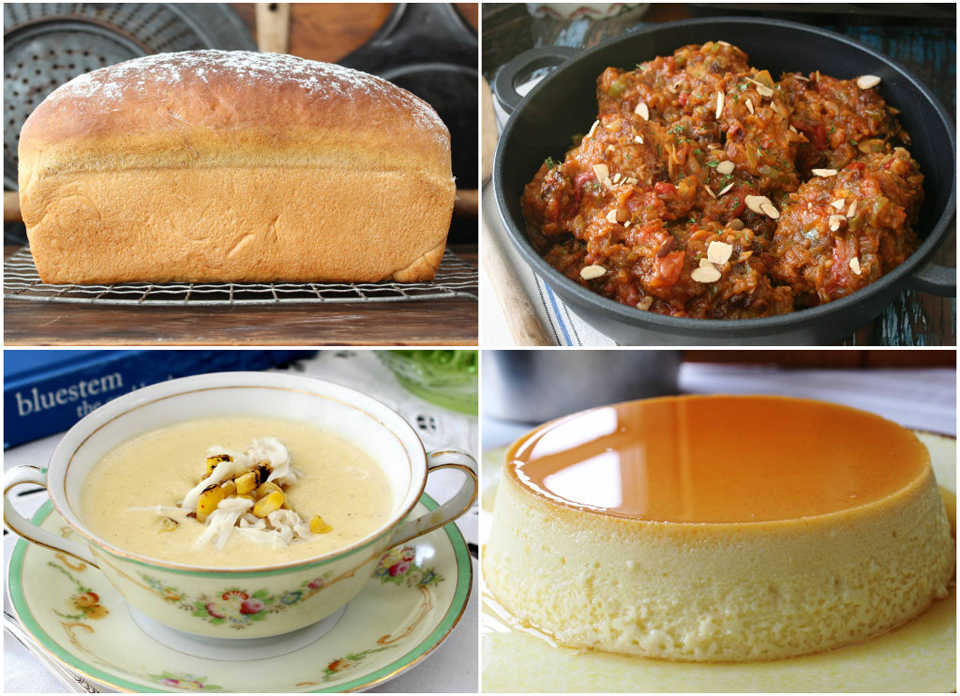Hard as it may be to grasp, 2015 is coming to a fast end. If you’ve followed this column over the years, you already know I keep record of which recipes you’ve reported to have particularly enjoyed and add them to the year’s “best recipe” list. Whether you’ve already tried them, or are still saving them in your “recipes to try” file, they are the kind of the recipes that merit attention. This year’s tops picks are Caramel Custard (September 9), Country Captain (April 8), Sweet Corn Soup, Maryland Blue Crab (April 22) and Soft White Bread (September 23).
The Caramel Custard recipe is topped with a syrup made by caramelizing sugar in the microwave oven – a technique you will find handy whether you are calling your dessert “flan,” “crème caramel,” or even “crème brûlée.”
You may personalize the Country Captain dish, a meal comprised of curried chicken that is always served with rice, by making your own exotic curry spice blend, and if the thought of a creamy soup, laden with corn, crab and good bit of spirit makes you swoon, now’s that second chance for making Sweet Corn Soup, Maryland Blue Crab, from “Bluestem: The Cookbook,” by Colby Garrelts and Megan Garrelts with Bonjwing Lee.
In addition, should your attempts at making homemade bread fallen flat, do try the recipe here for Soft White Bread. So long as you follow the directions precisely, you’ll achieve – or come close to achieving – that coveted “perfect” loaf.
Caramel Custard
Serving: 8
For the caramel
When caramelizing sugar in the microwave oven, watch it carefully so that it does not burn. Sugar, water and lemon juice goes from clear, to champagne color, then to amber in just minutes, Even after the mixture is removed from the oven, it will continue to cook and develop in color.
Due super-high temperatures, be sure to use Pyrex glass, or even laboratory glass for making caramel.
¾ cup granulated sugar
3 tablespoons water
¼ teaspoon lemon juice
Combine the sugar, water and lemon juice in a 2-cup glass Pyrex measuring cup. Cover with a piece of wax paper. Microwave on HIGH power for 2 minutes. Remove paper and microwave for 1½ minutes more. Watching carefully, so sugar does not burn, microwave at 20-second intervals on HIGH until mixture reaches an amber (honey-like) color. (Do not allow mixture get too dark, as sugar will continue to cook and darken even when it is removed from the oven. If your sugar smells burnt, it will taste bitter, and you will have to start over.)
Very carefully swirl sugar onto the bottom of a 1½- to 2-quart Charlotte mold, pudding basin, or 3- to 4-inch deep casserole. (The pan will be very, very hot, so be sure to place a pad under the pan to protect your counter top, or table.) Set pan aside and allow syrup to harden. While caramel is hardening, make custard.
For the custard
1 (14-ounce) can sweetened condensed milk
Fresh whole milk (use empty sweetened condensed milk can for measuring)
4 large eggs
1 teaspoon vanilla
Heat the oven to 350 F.
Pour sweetened condensed milk into the container of an electric blender. Using the empty sweetened condensed milk can, fill it to the top with milk, then pour the milk into the blender along with eggs and vanilla. Blend until well combined, then strain mixture through a fine mesh sieve. Pour mixture into mold or casserole on top of hardened caramel. Place mold into a baking pan large enough to hold the mold. Pour boiling water halfway up sides of pan. (This is called a “water bath.” A water bath surrounds the custard with an “insulation” of gentle heat to help prevent curdling. In France, a water bath is known as a “bain marie.”)
Bake for 1 hour until golden and a wooden skewer inserted within 1 inch from edge of custard comes out clean. (Do not be alarmed if the middle of the custard looks “wobbly.”) Carefully remove pan from oven and place it on wire rack to cool. Once cool, refrigerate several hours, or overnight, until cold.
When ready to serve, run a thin spatula along edge of custard to loosen slightly. To unmold, invert custard onto a platter, allowing sugar to run down sides.

